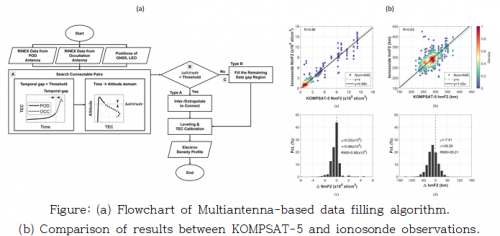Major research outcome
- Ph.D. Hyeyeon Chang and Professor Jiyun Lee, Multiantenna-based data filling method for retrieving electron density profiles from GNSS Radio Occultation data
- 관리자 |
- 2024-09-25 14:38:24|
- 180
- 2024-09-25 14:38:24|
The GNSS radio occultation(GNSS RO) technique is a remote sensing technique that derives Earth’s atmospheric characteristics, including the ionosphere, based on the delay and refraction of GNSS signals received by low Earth orbit(LEO) satellites. To retrieve the ionospheric electron density profile within the LEO altitude using GNSS RO, a calibration process is required to subtract the contribution above the LEO altitude from the occultation-side observations. However, due to the typical installation characteristics of RO antennas, it is difficult to separately observe the region above the LEO altitude. Previous studies have addressed this limitation by applying models and generating tomographic reconstructions.
Recently, Ph.D. Hyeyeon Chang and Professor Jiyun Lee have developed a multiantenna-based data filling method for retrieving electron density profiles from GNSS RO data. This method connects data from both RO and precise orbit determination(POD) antennas, providing observation-based results that reflect actual ionospheric phenomena. It also offers the advantage of producing effective outcomes using a simpler technique than tomographic implementation. By applying the developed algorithm, we derived the first ionospheric electron density profiles from the KOMPSAT-5 RO data and evaluated their performance by comparing the results with ionosonde measurements. The related paper has been published in IEEE Transactions on Geoscience and Remote Sensing(IEEE TGRS), volume 62, in 2024. The IEEE TGRS journal is a reputed journal that covers nearly the full range of interests in remote sensing (IF: 7.5, Q1).
https://doi.org/10.1109/TGRS.2024.3449337
Recently, Ph.D. Hyeyeon Chang and Professor Jiyun Lee have developed a multiantenna-based data filling method for retrieving electron density profiles from GNSS RO data. This method connects data from both RO and precise orbit determination(POD) antennas, providing observation-based results that reflect actual ionospheric phenomena. It also offers the advantage of producing effective outcomes using a simpler technique than tomographic implementation. By applying the developed algorithm, we derived the first ionospheric electron density profiles from the KOMPSAT-5 RO data and evaluated their performance by comparing the results with ionosonde measurements. The related paper has been published in IEEE Transactions on Geoscience and Remote Sensing(IEEE TGRS), volume 62, in 2024. The IEEE TGRS journal is a reputed journal that covers nearly the full range of interests in remote sensing (IF: 7.5, Q1).
https://doi.org/10.1109/TGRS.2024.3449337
| Attach File |
|---|


